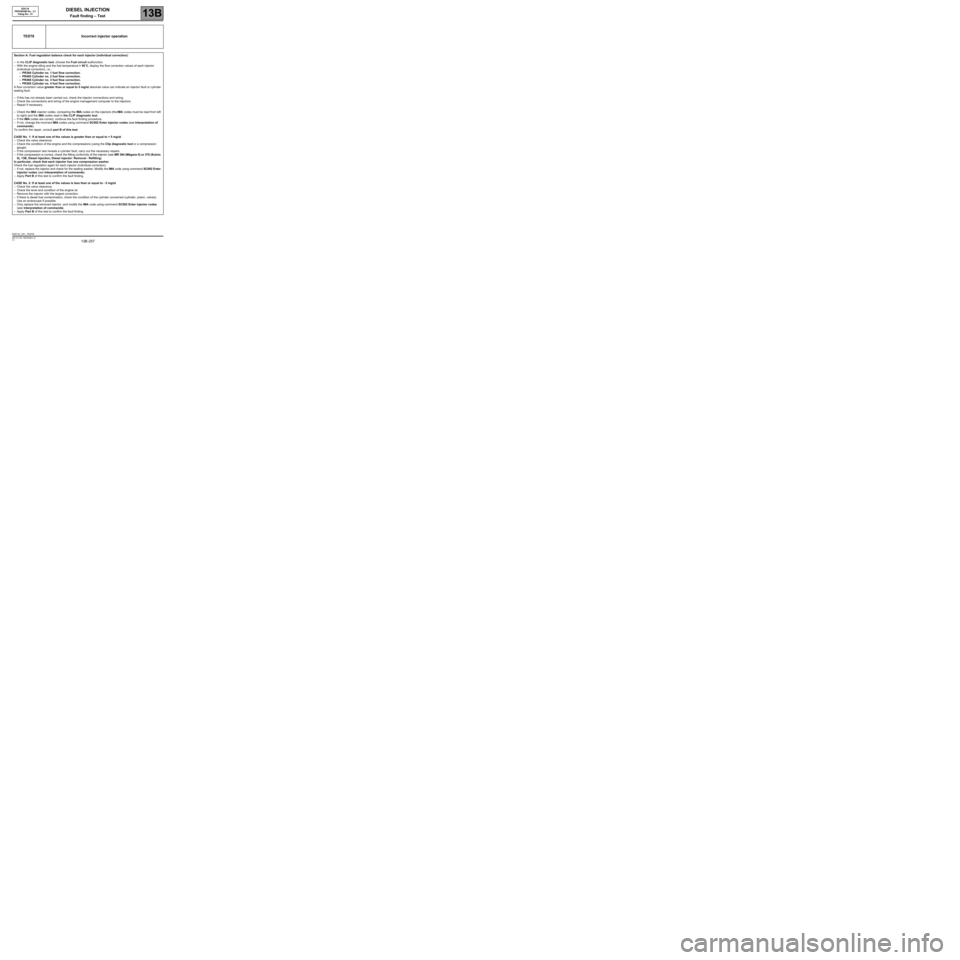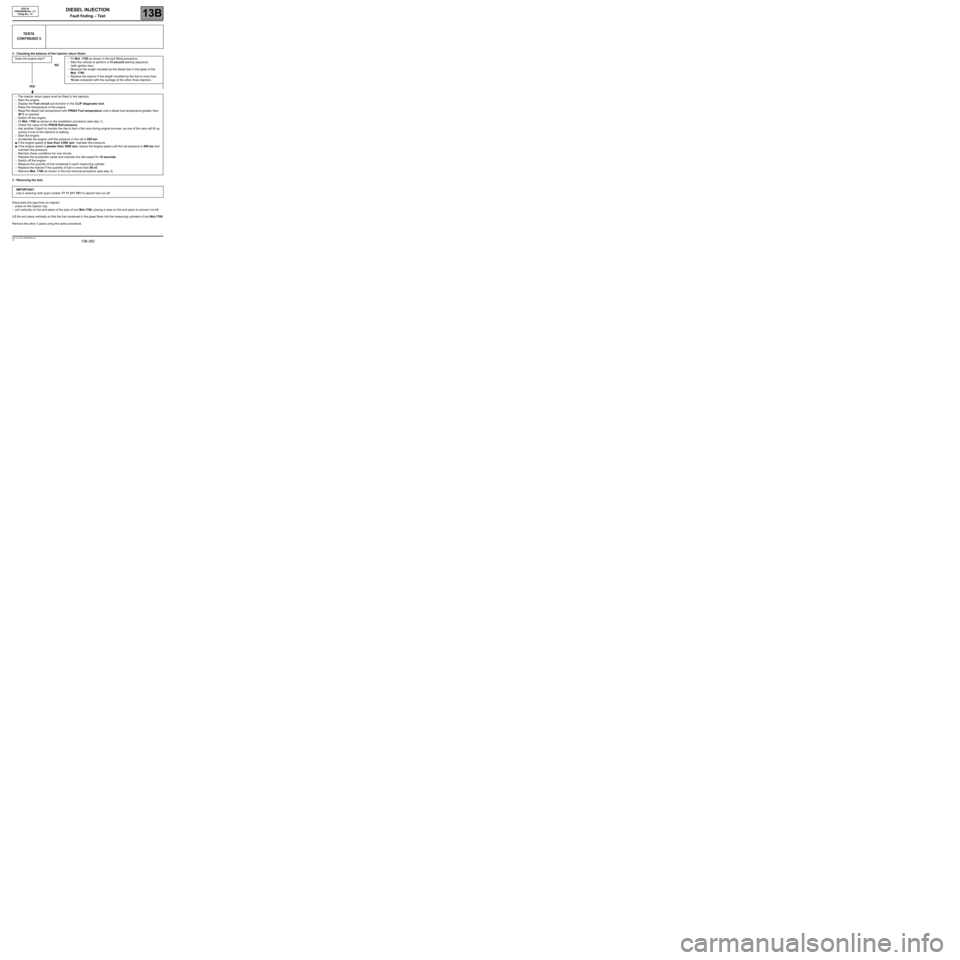2009 RENAULT SCENIC check engine
[x] Cancel search: check enginePage 250 of 273

DIESEL INJECTION
Fault finding – Test13B
13B -250V3 MR-372-J84-13B250$900.mif
EDC16
PROGRAM No.: C1
Vdiag No.: 51
TEST5
CONTINUED 2
Visual inspection of the solenoid valve electrical connector
Switch off the engine.
Note:
The requested checks are entirely visual.
1- Check that the connector is correctly connected and locked.
2- Check that the electric wires are not damaged where they leave the insulation.
Disconnect the connector to continue the checks.
3- Check that there is no heat damage to the unit and mechanical damage to the lock.
4- Check that the contacts (clips and tabs) are not deformed.
5- Check the sealing of the connector.
Do the visual inspections highlight any damage?
NO YES
If there is a repair procedure (see Technical
Note 6015A, Electrical wiring repair, Wiring:
Precautions for repair), repair the connector,
otherwise replace the wiring.
After repair, restart the test from the beginning.
C
1
Page 251 of 273

DIESEL INJECTION
Fault finding – Test13B
13B -251V3 MR-372-J84-13B250$900.mif
EDC16
PROGRAM No.: C1
Vdiag No.: 51
TEST5
CONTINUED 3
Check the vacuum at the solenoid valve inlet
Let the engine idle.
Disconnect the vacuum pipe from the solenoid valve inlet end piece.
This pipe connects the vacuum pump to the turbocharger solenoid valve.
Connect a vacuum pressure gauge to the end of the disconnected pipe and put it in the vacuum
measurement position.
Read the vacuum displayed by the pressure gauge.
Tolerance intervals to be respected for the vacuum value:
-1 bar < CORRECT vacuum value < -0.85 bar
-0.85 bar < INCORRECT vacuum value < 0 bar
Does the vacuum displayed at the solenoid valve inlet by the pressure gauge respect the tolerance
interval?
NO YES
Replace the solenoid valve (see MR 364 (Mégane
II) or 370 (Scénic II), Mechanical, 12B,
Turbocharging).
Carry out the following operations.
–reconnect the vacuum pipe to the turbocharger solenoid valve.
–Check the vacuum pipe or pipes are connected correctly.
–visually inspect the condition of the vacuum pipes from the vacuum pump to the various components supplied.
Refer to the repair manual (see MR 364 (Mégane II) or 370 (Scénic II), Mechanical, 12B Turbocharging).
C
1
Page 252 of 273

DIESEL INJECTION
Fault finding – Test13B
13B -252V3 MR-372-J84-13B250$900.mif
EDC16
PROGRAM No.: C1
Vdiag No.: 51
TEST6 Turbocharger
IMPORTANT
Perform these checks without removing the turbocharger and with the vehicle ignition switched off.
Check the turbocharger shaft
WARNING
Respect the following safety precautions:
–wear heat resistant gloves when the engine is hot,
–do not wear loose or baggy clothing and do not wear loose hanging jewellery,
–be aware that the cooling fan assembly may be triggered and pay attention to the operation of the accessories
belt or belts.
Note:
The turbocharger shaft is the shaft connecting the compressor wheel and the turbine wheel.
According to the vehicle type, maximum visual access will either be from above or from below.
Disconnect the air pipe located between the turbocharger and the air filter.
Wearing gloves, check the operation of the turbocharger shaft by turning the vanes manually without forcing.
Is there a point of resistance when the shaft is rotated?
Does the compressor wheel touch the turbocharger housing?
If for these 2 questions the response is NOIf YES for one of these 2 questions
Replace the turbocharger (see MR 364 (Mégane II) or
370 (Scénic II), Mechanical, 12B, Turbocharging,
Turbocharger: Removal - Refitting and Technical
Note 3938A, Broken turbocharger: Replacement
instructions).
EDC16_V51_TEST6
Page 257 of 273

DIESEL INJECTION
Fault finding – Test13B
13B -257V3 MR-372-J84-13B250$900.mif
EDC16
PROGRAM No.: C1
Vdiag No.: 51
TEST8 Incorrect injector operation
Section A: Fuel regulation balance check for each injector (individual correction):
–In the CLIP diagnostic tool, choose the Fuel circuit subfunction.
–With the engine idling and the fuel temperature > 50˚C, display the flow correction values of each injector
(individual correction), i.e.:
–PR364 Cylinder no. 1 fuel flow correction.
–PR405 Cylinder no. 2 fuel flow correction.
–PR406 Cylinder no. 3 fuel flow correction.
–PR365 Cylinder no. 4 fuel flow correction.
A flow correction value greater than or equal to 5 mg/st absolute value can indicate an injector fault or cylinder
sealing fault.
–If this has not already been carried out, check the injector connections and wiring.
–Check the connections and wiring of the engine management computer to the injectors.
–Repair if necessary.
–Check the IMA injector codes, comparing the IMA codes on the injectors (the IMA codes must be read from left
to right) and the IMA codes read in the CLIP diagnostic tool.
–If the IMA codes are correct, continue the fault finding procedure,
–If not, change the incorrect IMA codes using command SC002 Enter injector codes (see Interpretation of
commands).
To confirm the repair, consult part B of this test.
CASE No. 1: If at least one of the values is greater than or equal to + 5 mg/st
–Check the valve clearance.
–Check the condition of the engine and the compressions (using the Clip diagnostic tool or a compression
gauge).
–If the compression test reveals a cylinder fault, carry out the necessary repairs.
–If the compression is correct, check the fitting conformity of the injector (see MR 364 (Mégane II) or 370 (Scénic
II), 13B, Diesel injection, Diesel injector: Removal - Refitting)
In particular, check that each injector has one compression washer.
Check the fuel regulation again for each injector (individual correction).
–If not, replace the injector and check for the sealing washer. Modify the IMA code using command SC002 Enter
injector codes (see Interpretation of commands).
–Apply Part B of this test to confirm the fault finding.
CASE No. 2: If at least one of the values is less than or equal to - 5 mg/st
–Check the valve clearance.
–Check the level and condition of the engine oil.
–Remove the injector with the largest correction.
–If there is diesel fuel contamination, check the condition of the cylinder concerned (cylinder, piston, valves).
Use an endoscope if possible.
–Only replace the removed injector, and modify the IMA code using command SC002 Enter injector codes
(see Interpretation of commands).
–Apply Part B of this test to confirm the fault finding.
EDC16_V51_TEST8
Page 262 of 273

DIESEL INJECTION
Fault finding – Test13B
13B -262V3 MR-372-J84-13B250$900.mif
EDC16
PROGRAM No.: C1
Vdiag No.: 51
2 - Checking the balance of the injector return flows:
3 - Removing the tool:
Disconnect the pipe from an injector:
–press on the injector clip,
–pull vertically on the end piece of the pipe of tool Mot.1760, placing a wipe on the end piece to prevent run-off.
Lift the end piece vertically so that the fuel contained in the pipes flows into the measuring cylinders of tool Mot.1760.
Remove the other 3 pipes using the same procedure.
TEST8
CONTINUED 5
Does the engine start? – Fit Mot. 1760 as shown in the tool fitting procedure.
–Start the vehicle or perform a 15 second starting sequence
(with ignition key).
–Measure the length travelled by the diesel fuel in the pipes of the
Mot. 1760.
–Replace the injector if the length travelled by the fuel is more than
10 cm compared with the average of the other three injectors. NO
YES
–The injector return pipes must be fitted to the injectors.
–Start the engine.
–Display the Fuel circuit sub-function in the CLIP diagnostic tool.
–Raise the temperature of the engine.
–Read the diesel fuel temperature with PR063 Fuel temperature until a diesel fuel temperature greater than
50˚C is reached
–Switch off the engine.
–Fit Mot. 1760 as shown in the installation procedure (see step 1).
–Check the value of the PR038 Rail pressure.
–Ask another Cotech to monitor the rise in fuel in the cans during engine turnover, as one of the cans will fill up
quickly if one of the injectors is leaking.
–Start the engine.
–Accelerate the engine until the pressure in the rail is 550 bar:
●if the engine speed is less than 3,000 rpm, maintain this pressure.
●if the engine speed is greater than 3000 rpm, reduce the engine speed until the rail pressure is 500 bar and
maintain this pressure.
–Maintain these conditions for one minute.
–Release the accelerator pedal and maintain the idle speed for 10 seconds.
–Switch off the engine.
–Measure the quantity of fuel contained in each measuring cylinder.
–Replace the injector if the quantity of fuel is more than 50 ml.
–Remove Mot. 1760 as shown in the tool removal procedure (see step 3).
IMPORTANT:
Use a cleaning cloth (part number 77 11 211 707) to absorb fuel run-off.
Page 265 of 273

DIESEL INJECTION
Fault finding – Test13B
13B -265V3 MR-372-J84-13B250$900.mif
EDC16
PROGRAM No.: C1
Vdiag No.: 51
TEST9
CONTINUED
High pressure circuit check
Note:
According to the vehicle type, maximum visual access will either
be from above or from below.
Visually inspect the condition of the following components:
–outlet pipe of the compressor to the turbocharging air cooler,
–turbocharging air cooler outlet pipe at inlet manifold,
–inlet manifold,
–temperature and pressure sensors.
Is one of these components incorrect (disconnected, cut,
bent, pierced or kinked pipes)?YESReplace
the defective parts
(see MR 364
(Mégane II) or 370
(Scénic II),
Mechanical, 12B,
Turbocharging).
NO
Exhaust system check
Visually inspect the condition of the following engine parts:
–the exhaust manifold circuit to the turbocharger turbine,
–the turbine outlet pipe to the end of the exhaust pipe,
–the inlet manifold to the EGR valve
–check that the temperature and pressure sensors are
connected.
Do some of these components have black or white marks on
them? YES
NO
Run test 5 Turbocharger control solenoid valve check.